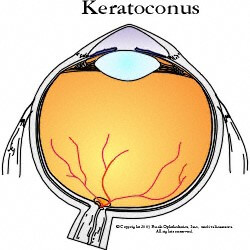If you suffer with the progressive disorder known as keratoconus, we have great news!
On April 18, 2016 the FDA approved a treatment to kick your keratoconus. Now it is possible to “kick” your keratoconus with collagen cross linking. This treatment will also help patients who have developed ectasia after having LASIK, and although rare, it also presents serious issues for patients.
This remarkable new treatment has been performed in the USA for some time for “off label” use. This means it had not been totally vetted, and the FDA had not officially approved its use for a particular disorder or surgical treatment. That has now changed!
If you, or someone you know, has keratoconus, corneal collagen cross linking is now an approved treatment, and you should understand what it is and how it benefits patients with keratoconus.
What is Keratoconus
Keratoconus is an eye disease in which the corneal tissue becomes progressively thinner and weaker causing the cornea to bulge. Our cornea is normally a round shape but with this disease it slowly becomes conical. This results in distorted vision and it becomes difficult to see clearly even with glasses. It is also problematic to fit contact lenses.
Patients become more nearsighted, and irregular astigmatism also occurs causing glare and sensitivity to light.
Keratoconus usually begins in the teens or twenties and affects approximately 1 out of every 2000 patients in the US. Patients with keratoconus commonly find they need to change their prescription frequently. Worst case scenario is a patient will require a corneal transplant.
Dr. Lisa Marten is a corneal specialist at South Texas Eye Institute. She performs corneal transplants, implants corneal Intacs, and does collagen cross linking (CXL) procedures.
Risk Factors for Keratoconus
Scientists have been studying why a patient develops keratoconus, and it is not clear why the corneal tissue weakens. Recently they have concluded that it could be an enzyme in-balance in the cornea making it more vulnerable to free radical damage.
Other associations include:
- Keratoconus seems to run in families.
- Wearing poorly fitted contact lenses for a long period of time
- Having chronic eye irritations
- Not wearing sunglasses resulting in too much exposure to UV sunlight.
How Collagen Cross Linking Works
There have been multiple treatments over the years for keratoconus, like wearing rigid gas permeable contact lenses or inserting corneal Intacs, but collagen cross linking is now in the forefront. It is not considered a cure, but it stops the progression of the disease, strengthens the cornea and helps to flatten it.
 Trained as a corneal specialist, Dr. Marten has extensive knowledge about corneal cross linking.
Trained as a corneal specialist, Dr. Marten has extensive knowledge about corneal cross linking.
The type of procedure known as Trans-epithelial Collagen Cross Linking uses a riboflavin solution (Vitamin B2) plus UV light to strengthen the chemical bonds of the cornea. This combination could be likened to “knitting together” or linking the layers of the cornea to aid in strengthening it.
As of April 2016, the corneal collagen cross linking system by Avedro, Inc. known as Photexra® (KXL) is the first and only FDA approved treatment for progressive keratoconus. The clinical trials for KXL showed not only a halt in the bulge caused by keratoconus but a mild reversal as well.
Cross Linking 2 Ways
There are 2 approaches to corneal cross linking:
- Epithelium Off cross linking – first removes the outer layer of the cornea and then saturates the stromal bed with the riboflavin liquid. Then a prescribed amount of UV light is applied.
- Epithelium On cross linking – leaves the outer layer of the cornea intact. It is also known as trans-epithelial cross linking. This particular approach has less risk for infection, heals faster, has less haze afterward, and is more comfortable for the patient.
Both approaches have advantages and disadvantages.
The entire procedure lasts approximately 1 to 1.5 hours. Antibiotic and anti-inflammatory drops are used afterward with both approaches to promote healing and prevent any infections. No serious complications have been known to occur after the procedure and patients retain their normal tear film.
Take Away Message
For those patients who must deal with distorted vision due to keratoconus, now there is a way to kick your keratoconus with collagen cross linking. Up until recently is was performed in the US off label. Now it has been FDA approved.
Corneal specialist Dr. Lisa Marten will perform tests to make sure you are a good candidate for this procedure and afterwards will follow your healing process and continued improvement.
Finally there is a treatment for keratoconus.
Trust your eyes to the corneal specialists at South Texas Eye Institute.

